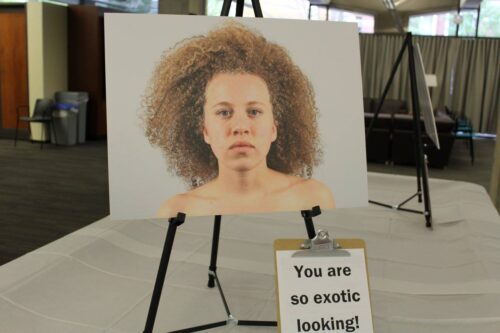Multiracial and Multiethnic students celebrate their backgrounds in Other.
‘Other,’ the 58-photograph gallery displayed in the SOCH, began last March when Amanda Mozea ‘17 developed the concept of how the perceptions of others weigh in on how multiracial individuals view their own identity. However, as her models would agree, the question of identity and what race means began long ago for Amanda.
Mozea titled her gallery “Other” to reflect the box on censuses and standardized tests that many multiracial students have become familiar, yet uncomfortable, with checking. After asking her models how the government defined their race, the responses overwhelmingly echoed the resentment of having no choice but to check off ‘other’ and struggling with the compromise. “I hated checking that box,” explained Mozea. Underneath the portraits were quotes taken from interviews Mozea did with each model that reflected their struggles with defining and defending their identities. ‘Other’ asked participants how other people defined their race as well as how they defined themselves in order to bridge how identities are affected by others’ perceptions.
Mozea’s multi-racial identity has been an integral part of her Harvard experience and has affected how she interacts with cultural groups on campus. Remembering how someone at a cultural group’s event made a comment to her about her identity, Mozea explains that she had always been confused but had never considered her multi-racial identity based solely on appearance. When confronted about how her multiracial identity shaped the way she was viewed by others in her cultural group, Mozea began considering how perceptions of race are formed and where the basis for these judgments lie.
While this may have inspired the gallery, Mozea says that it became about “looking forward rather than looking back.” The goal of the gallery is to begin a discussion on campus that invites students who are multiracial and otherwise to consider how identities are formed and the ways in which they influence us. ‘Other’ grew out of a lack of community but has henceforth formed a new support system for Harvard students to express their multiracial identities with a sense of pride. However, even students who didn’t relate to feeling ‘othered’ joined in the discussion and expanded the scope of the gallery to include the Harvard community as a whole.
Not only has Mozea’s gallery received positive feedback from students, but also the UC voted to award ‘Other’ with Dean Khurana’s Bridging and Belonging Grant, which recognizes projects uniting groups on campus that wouldn’t otherwise collaborate. Many cultural groups who had previously not collaborated worked together to support ‘Other,’ and many models were members, and even on the board, of one or more cultural groups. After inviting cultural groups and recruiting support for the gallery to increase exposure, Mozea had many proactive members of these communities who hoped to be included as models.
Participation of these groups began discussion of how multiracial students have felt forced to compromise their identity and defend part of themselves depending on who they were around. Through the project, many models expressed feeling torn between choosing one side or another of their heritage, ultimately forcing part of their background out. The support of these previously separate cultural groups allowed for the beginning of a bridge between identities of multiracial members.
While the gallery is no longer on display in the SOCH, Quincy and Pfoho will be exhibiting some of the portraits from ‘Other’ in their art spaces later this year. However, Mozea and her models are hoping for multiracial cultural groups on campus to create an inviting space and to be a part of its creation. Following the gallery, Mozea was proud of the discussion among students. Multiracial students expressed more pride in their identities as well as students who weren’t multiracial that have felt ‘Othered.’ Students who weren’t multiracial but hoped to find common ground and support others by combining different experiences strengthened the support for the gallery.
While Mozea initially hoped to convince 20 models to participate, she was met with over 70 proactive individuals eager to discuss their experiences with multiracial identities. Mozea said that speaking with her models about their experiences benefited her most of all and became cathartic. “We all went through an identity crisis together,” said Mozea of the group being able to gain peace of mind and find a supportive community. After struggling to find a community, Mozea and her models have inspired discussion and created a safe space for students to express their identities.
Hunter Richards ’18 (hrichards@college.harvard.edu) believes that race and culture are more than skin deep.

